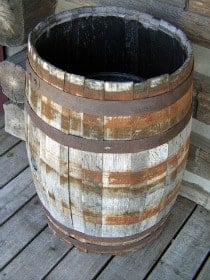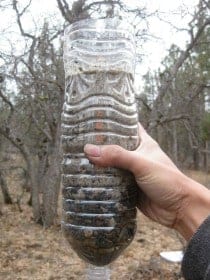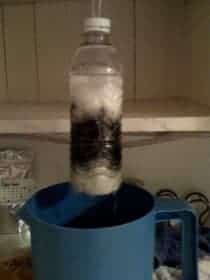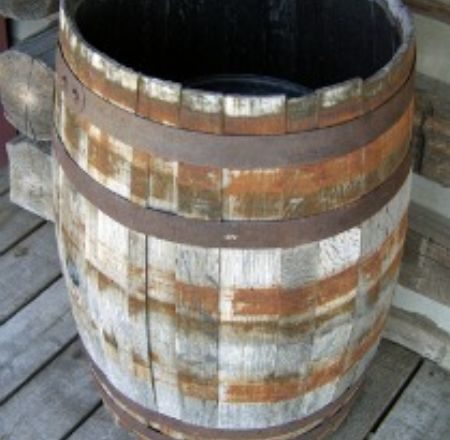We’ve had a lot of rain up here lately. A LOT of rain. I was out puttering around the yard this week and I noticed the rain water slowly dripping through my raised fire pit and the wood coals it was full of. Drip drip drip…… into a puddle below.
By Calamity Jane, a contributing author of SurvivalCache.com
Do It Yourself
That got me thinking, is that some kind of charcoal filter happening there? What is the difference between a pile of wood charcoal and an  activated charcoal filter? Can I make an activated charcoal filter to filter water through for drinking?
activated charcoal filter? Can I make an activated charcoal filter to filter water through for drinking?
The first thing I learned when I started searching the answers to those questions, is that activated charcoal is in no way the same as burnt wood. Activated charcoal is charcoal that has been treated with oxygen to open up millions of tiny pores between the carbon atoms. It’s a specialized manufacturing process, requiring temperatures in the 1000 degree F range. (Or really dangerous chemicals and temperatures in the 600 degree range.)
Well, shoot. There went my whole DIY activated charcoal plans. What can I still do? Make charcoal? I’m quite the pyro, I burn a fair bit of wood. How far will that get me towards a water filter?
Read: Expedient DIY Family Survival Water Filter (Click Here)
It turns out, that regular charcoal was used for water filtering for a long time before we figured out activated charcoal. In its natural state it contains the atoms that neutralize odors and filter water. Activated charcoal just has those atoms in larger quantities. (For those interested in such things, apparently activated charcoal made from coconut shells is better than that made from wood.)
So regular charred wood will work. Just not as well. You can increase the amount of regular charcoal, or increase the contact time of the water to charcoal to make up for the lesser effectiveness. And remember, there are specific ways to make good charcoal. Check this out.
To recap here, I don’t think you can make your own Activated Charcoal, especially not for less than what you can find for it online. And probably not safely, considering the temperatures involved. But, if you want a DIY water filter, you can buy the Activated charcoal and DIY everything else. You need to plan your filter to allow proper time for the AC to adsorb the contaminants, the water has to be in contact with the carbon filter for longer than a second. You’ll also want a sediment filter before the activated charcoal filter, since they don’t work as well for the bigger particles. Sediment filters can be fine sand or gravel. The sediment filter will grab things like sand and rust particles. Don’t send boiled water immediately through an AC filter, it works best at room temperature.
More Info
Here’s a great PDF (Click Here) from my neighbors to the North, the North Dakota State University. “Filtration: Sediment, Activated  Carbon and Mixed Media” If you are looking for a good overview of your various DIY options for water filtration.
Carbon and Mixed Media” If you are looking for a good overview of your various DIY options for water filtration.
They start with a good reminder to get your water tested so you KNOW for sure, exactly what kinds of things you’ll need to be filtering out. No, this is not a service that will be available post grid crash. Yes, you should get this done before that happens. Then expect your water quality to get worse post-crash, not better. See Road Warrior’s post from SHTFBlog.com for one of the reasons why (Click Here). Think of your filtering needs as layers. The sediment filter removes things like rust and sand. The AC filter removes or reduces organics that can affect taste, odor and color, chlorine, trihalomethanes (THM), pesticides, industrial solvents (halogenated hydrocarbons), polychlorinated biphenyls (PCBs), and polycyclic aromatic hydrocarbons (PAHs). A round of Ultraviolet (UV) treatment can be done quite simply with clear 1 L plastic water bottles set in the sun for a few hours. UV will remove a lot of microorganisms that could make you sick, microorganisms that an AC filter won’t catch. Check out this doc (Click Here) for a great 101 on UV water treatment. They’ve got a great chart on UV dosages required to kill a whole list of organisms, Bacteria, mold, viruses and yeasts.
Remember to account for filter replacement. If you want 3 months worth of water filtration, but your rate of water usage means you’ll need to replace the filter every 2 weeks, you’ll have to have 6 replacement filters on hand. Your rate of water usage can be calculated by taking the Number of People x Average Daily Water Usage. And remember to count your people correctly, will your son’s best friend who lives with a dead-beat dad be over every day? Will your brother-in-law bring his family out to your place if the city loses water/power? Your water usage number will be a gallons/day number. Most filters will tell you how many gallons of water they can filter before cleaning or replacement is necessary. So Filter Life divided by your Usage Rate will tell you how many days that filter will last at that rate.
to replace the filter every 2 weeks, you’ll have to have 6 replacement filters on hand. Your rate of water usage can be calculated by taking the Number of People x Average Daily Water Usage. And remember to count your people correctly, will your son’s best friend who lives with a dead-beat dad be over every day? Will your brother-in-law bring his family out to your place if the city loses water/power? Your water usage number will be a gallons/day number. Most filters will tell you how many gallons of water they can filter before cleaning or replacement is necessary. So Filter Life divided by your Usage Rate will tell you how many days that filter will last at that rate.
Keep that Usage Rate in mind when you are designing the system. Do you have a place to hold the needed water, before and after filtering? If you know you’ll need 12 gallons a day, do you want to hold 6 at a time and filter twice a day? Or hold 24 gallons and filter once every 2 days?
Read SHTFBlog.com – Options for Drinking Water (Click Here)
If you find you need some small parts, there are kits online with just those small parts that you can buy. Like this one.
What kinds of water purification do you have planned? Anyone working on some DIY Filters? The last time I made one was in high school, for an aquaculture class. It could be a good time to revisit that experience and see what I can whip up for my family. Sound off in the comments below if you have ideas or actual plans that you’ve followed.







I’m getting materials together to make a 3-stage filter out of 5 gal. buckets: pea gravel, coarse sand (or pool filter sand) and charcoal for showering, since I have stored drinking water in 55 gal. drums. Perusing the web to find out how much of each I’ll need. Suggestions?